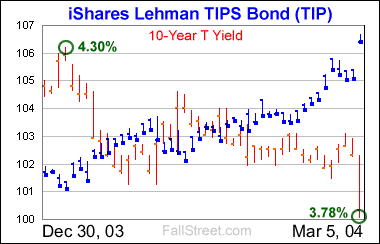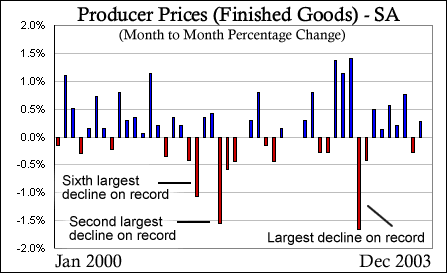March 10, 2004
Two Wish List Selections Benefiting from Dangerous Fed Policies
Platinum is hitting 24-year highs, and silver is trading above $7 an ounce. Gas prices are threatening record highs, oil is hitting post-Iraq highs, and OPEC – primarily due to the weak US dollar - is no longer concerned that higher oil prices will stifle economic activity and send oil prices crashing lower. According to Salina Steel Supply, raw steel products cost 40% to 60% more across the board since mid-December. Materials like copper have strengthened and China is sending out teams across the globe to scavenge for more supply. Lastly, despite battling deflationary forces for the last 6-years Japan recently sold inflation-linked bonds for the first time ever. The Japanese sale of 100 billion yen ($918.1 million) of inflation-linked securities maturing in 10-years brought double the amount of bids the sale of benchmark 10-year bonds drew days earlier.
Suffice it to say, and as central bank Chief Zhou Xiaochuan was recently quoted as saying, “Currently, the inflationary trend is obvious”. However, what is considerably less obvious is why members of the US Federal Reserve Board continue to believe that inflation is a non issue. Indeed, in its latest FOMC statement the Fed said “increases in core consumer prices are muted and expected to remain low”, and “inflation [is] quite low and resource use slack”. Moreover, the Fed said “The probability of an unwelcome fall in inflation has diminished in recent months and now appears almost equal to that of a rise in inflation’. The US economy is growing strongly and commodity prices are firming, yet the Fed says that inflation is almost as much of a threat as deflation? Is something amiss?
In fact, what the Fed is concerned about – but what Greenspan and company will not openly admit - is that monetary and fiscal stimulus undertakings could be giving the US economy an unsustainable boost. The fear here is that once the Fed begins to raise interest rates – to combat inflation and/or to try and stop a slide in the US dollar – that the US economy will be unable to sustain growth. This theory makes sense. After all, any jump in interest rates could pierce the proverbial ‘housing/refi bubble’, which has been one of the major drivers of growth in the last year.
Conversely, the Fed is also concerned about the dangers of maintaining a zero bound interest rate policy. Quite frankly, and although Bernanke has speculated that alternative stimulus measures will work just as effectively as rate cuts (i.e. buying long term bonds), by using up ammo to try and spur an immediate recovery in the US economy the Fed has less ammo available to combat any future financial crisis. During the 1990s the Fed rescued the markets following LTCM, the Asian crisis, and [pre-emptively] Y2K. What will the Fed do when the next financial crisis arrives?
In short, if you look at specific assets over the last year (i.e. stocks and houses) it is clear that an inflationary trend exists. Moreover, and using the first paragraph as a starting point, it is clear that many dollar denominated commodities are increasingly in value not only because of the dollars decline, but also because of a stronger demand picture. By ignoring the threat rising asset prices could pose and overlooking the rally in commodity prices the Fed could be playing a dangerous game – a game of wait and see that the Fed hopes will bring about a more sustainable recovery (i.e. jobs growth), but could just as easily lead to popping asset prices and continued US dollar weakness.
Two Wish List companies have benefited from the Fed’s potentially dangerous policies, and are likely to continue to benefit in the future.
ML Macadamia Orchards LP
A weaker US dollar/stronger Aussie dollar makes Australian macadamia nuts imports to the US less competitive. As previously speculated, “Mauna Loa should reap the rewards of a declining US dollar well before the USDA price for macadamias shows a notable increase.” Speculation becomes reality: the partnership reported $406,000 in net income (compared to a $136,000 loss in 4Q02) as prices received from Mauna Loa increased by 18% in 2003. The USDA portion of the nut price in 2003 decreased 5%.
NUT raised its distribution back to 5 cents a share yesterday (implied forward yield of 5.2%). The company should continue to benefit from a weaker US Dollar.
iShares Lehman TIPS Bond
TIP has already rallied by 5.3% this year (not including distributions). Despite the fact that the increase in the consumer price index has been tame (+1.97% in Jan), loose Fed policies continue to suggest that inflationary pressures could develop.
 |
Conclusions
Even though higher inflation/weaker dollar should continue to help NUT and TIP, there are concerns. For NUT, continued weakness in the dollar would be beneficial, but not if demand for macadamia nuts does not remain strong in the United States. As for TIP, it should be remembered that the latest surge in TIP’s ETF price has been because of the decline in US interest rates following last weeks weaker than expected jobs report. As interest rates move lower the expected return on TIP becomes more attractive so long as the outlook for consumer prices remains firm. However, if TIP is yielding 1.5% with a 1.9% CPI kicker (3.4% total), it would be a dangerous bet to assume that a jump in the 10-year yield (say to 4.5%) would be good news. On the contrary, unless inflationary forces are building strongly as US interest rates rise TIP’s unit price will likely decline.
The government has not released January’s PPI, and, according to the BLS, February’s report may also be delayed. To note: producer prices typically spot inflationary pressures before consumer prices do. On a month-to-month seasonally adjusted basis the consumer price index has fallen in 4 out of the last 10-months. The CPI is rising at less than 2% a year.
 |
Some analysts conclude that tame reports on inflation are the result of the government’s unique interpretation of inflation (i.e. inflation is at 40-year lows, but only if you ignore skyrocketing costs seen in housing, groceries, health care, etc). However, others – notably Federal Reserve Board members - believe that productivity increases are largely responsible for containing any noticeable increase in inflation. Regardless, the only thing everyone agrees on is that inflation, at least for the moment, is irrelevant when it comes to monetary policy; that the Fed is unlikely to begin raising interest rates until the US jobs market begins to show noticeable improvement.
Whether or not the Fed is playing a dangerous game by keeping policies loose until the jobs arrive will ultimately be determined at some point in the future. Nevertheless, and even though the Fed says that inflation is nonexistent, TIP has outperformed the Nasdaq and Dow this year: apparently many investor’s have decided that great stock market reflation boom is no longer worth chasing.